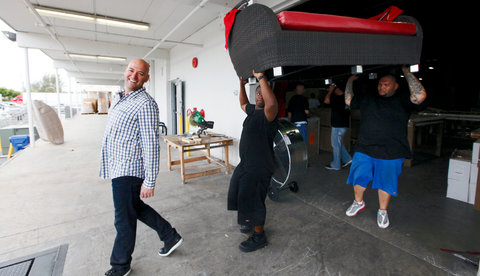She Owns It
Portraits of women entrepreneurs.
 Sara Krulwich/The New York Times Jessica Johnson doesn’t mind letting some customers go.
Sara Krulwich/The New York Times Jessica Johnson doesn’t mind letting some customers go.
At the last She Owns It Business Group meeting, the owners talked about several issues related to pricing. This post focuses on the prices charged by the two family businesses in the group, and the particular challenges of selling a product that is sold online for less.
Deirdre Lord, who owns the Megawatt Hour, had a question for Jessica Johnson and Susan Parker. Both took over businesses handed down from their parents, and Ms. Lord wondered whether they inherited pricing schemes as well.
Ms. Johnson, who owns Johnson Security Bureau, said she inherited the terms on certain contracts that were not yet up for renewal. When she eventually approached at least one of those clients to discuss rate increases, the client protested that other companies offered to handle the job for less. As she has said previously, Ms. Johnson doesn’t mind letting that kind of customer go.
She said her more savvy clients understood that external factors affected pricing and they would incorporate rising costs into their contracts. “That’s the kind of business we prefer to go after now, as opposed to, ‘No, you signed the paper, you’re stuck with it forever,’” she said.
In light of the Affordable Care Act, which will require businesses with more than 50 employees to provide health insurance for those employees, these considerations will become even more important, said Ms. Johnson, whose company had more than 100 employees and had not previously offered health insurance. “I’ve been running the numbers for several of our contracts looking at what’s going to happen when health care kicks in next year,” she said, adding that she had been proactive about talking to clients about how her prices could be affected. “We can kind of set the table and let them know that a price increase may be coming and see if that means that they’ll stay with us or they’ll go to someone else.”
Ms. Parker owns Bari Jay, which manufactures bridesmaid and prom dresses. She’s the only owner in the group with a company that sells a product, not a service. When she and her sister took over Bari Jay, the prices of the dresses already on the market remained the same, she said. But soon after, their factories raised their prices, and they, in turn, raised theirs as well.
“I had no one to teach me how to price a dress, so I came up with my own formula,” she said.
“Is it working?” asked Beth Shaw, who owns YogaFit.
“Really well,” Ms. Parker said.
“Do you take your fixed costs and then do you divide that up by the number of units you sell a year?” Ms. Shaw asked.
“Yes, and then I add a margin on top of it,” Ms. Parker said. While stores have complained that her prices have gotten high, she said higher prices are a bridal-industry phenomenon. “Making a dress in China has gotten really expensive,” she said.
Like other bridal companies, Bari Jay sells a sample dress to its stores, which then place orders based on the sample. About 10 years ago, Ms. Parker said, many of Bari Jay’s competitors started giving away free samples. “My father tried it, and it almost put him out of business,” she said. So, instead, Bari Jay offers volume discounts.
“That’s a great idea,” said Alexandra Mayzler, owner of Thinking Caps Group.
“There’s an incentive to buy more dresses, and if you buy less than the minimum, then you’re going to pay full price,” Ms. Parker said.
“With pricing, you definitely have to do what Susan was saying: think about cost, all of the math, but then you have to say to yourself, ‘Who am I going to sell it to?’” Ms. Mayzler said. You have to determine what they expect and whether you’re willing to “deal with the relationships that come because you’re in a particular price bracket,” she continued.
Ms. Parker agreed and explained that she doesn’t rely exclusively on her formula. For example, if her formula demands that a certain dress be priced $10 more than another, but the lower-priced dress looks more expensive, she will “tweak” the prices accordingly. She also explained how price perception affects her business. Bari Jay sells to stores, which then sell to customers. “All of our stores pretty much adhere to M.S.R.P.,” she said, referring to the manufacturer’s suggested retail price.
But on the stores’ Web sites, it’s a different story. Customers buying online can get the same dresses for less, said Ms. Parker. But they don’t receive the services, like a fitting they would get at the physical store. When you buy online, Ms. Parker said, “They’ll send it to you in a ball and if it has a stain or damage, it’s on you.” This annoys the stores that carry Bari Jay but don’t sell online. And it bothers Ms. Parker and her sister. “It cheapens our name,” she said, adding that customers who are willing to pay more don’t want to wear a dress that someone else was able to buy for half the price.
You can follow Adriana Gardella on Twitter.
Article source: http://boss.blogs.nytimes.com/2013/05/28/the-challenges-of-raising-prices-and-competing-with-online-retailers/?partner=rss&emc=rss




